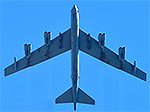B-52s arrive in Qatar to join bombing campaign against ISIS
 U.S. Air Force B-52 bombers arrived at Al Udeid Air Base, Qatar, on Saturday joining Operation Inherent Resolve, the American-led campaign against the Islamic State group.
U.S. Air Force B-52 bombers arrived at Al Udeid Air Base, Qatar, on Saturday joining Operation Inherent Resolve, the American-led campaign against the Islamic State group.
The deployment marks the first time the Air Force will use the Cold War-era warplanes — from Barksdale Air Force Base, Louisiana — in the counter-ISIS fight in Iraq and Syria. The service did not disclose the exact number of bombers it deployed.
"The B-52 will provide the coalition continued precision and deliver desired airpower effects,” Lt. Gen. Charles Q. Brown Jr., commander of U.S. Air Forces Central Command and Combined Forces Air Component, said in a release.
“As a multi-role platform, the B-52 offers diverse capabilities including delivery of precision weapons and the flexibility and endurance needed to support the combatant commander's priorities and strengthen the coalition team."
In March, Air Force officials hinted that the aircraft, affectionately known as the "Big Ugly Fat Fellow," would replace the B-1 Lancers, which returned in January.
"There have been recent infrastructure improvements that now allow the necessary support to deploy the B-52 in theater," Air Force Secretary Deborah Lee James said at an Air Force briefing on March 7.
Despite being the Air Force inventory for more than 50 years, BUFFs can drop precision-guided weapons. Its payload capacity at 70,000 pounds can include gravity bombs, cluster bombs, precision guided (cruise) missiles and joint direct attack munitions.
The service is focusing on a modernization effort to make sure the B-52s stay flying for years to come, potentially as late as 2040, officials have said.
The last time B-52s were in theater, they deployed for Exercise Eager Lion, a USCENTCOM-led exercise in Jordan in May 2015, the release said. The aircraft last flew operationally in 2006 during Operation Enduring Freedom; BUFFs were also based in Saudi Arabia supporting Operation Desert Storm.
“We’re going to keep the B-52 around. It provides some missions for us that are hard to replicate, primarily the range and payload the airplane provides,” Lt. Gen. James “Mike” Holmes, the deputy chief of staff for strategic plans and requirements, told Air Force Times on Feb. 18.